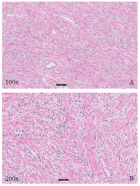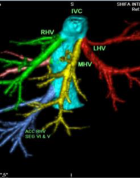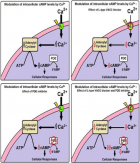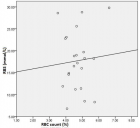Abstract
Review Article
Obesity may increase the prevalence of Parkinson’s Disease (PD) while PD may reduce obesity index in patients
Li Xue Zhong*, Muslimat Kehinde Adebisi, Liuyi, Mzee Said Abdulraman Salim, Abdul Nazif Mahmud, Aaron Gia Kanton and Abdullateef Taiye Mustapha
Published: 06 April, 2020 | Volume 4 - Issue 1 | Pages: 024-028
Objective: Currently, Parkinson’s disease (PD) is becoming more common among younger people of ages from 30 – 40 years. The incidence is higher among patients with higher body mass index (BMI), and some reports had it that Obesity is a risk factor for PD while some reported that there is no relationship between obesity and PD. PD patient at the time of diagnosis has an above-normal BMI but which goes below normal as the disease progresses. Therefore, it is essential to explore the relationship between PD and Obesity.
Methods: 349 outpatients and inpatients with PD were selected from Jiangsu University Affiliated People’s Hospital from January 2014 to December 2018, while 74 inpatients with non-cerebrovascular illness in the same period were selected as the control group. According to Hoehn-Yahr grade, Parkinson’s patients were divided into three groups. The height, weight, waist and hip circumference, total cholesterol (TC), Total Glycerol (TG), high-density lipoprotein cholesterol (HDL-C) and low-density lipoprotein cholesterol (LDL-C) were measured and recorded. The relationship between the severity of Parkinson’s disease and blood lipids was evaluated.
Results: The BMI of patients with PD in the early stage was higher than that of the control group, but lower than that of the control group in the late stage, and the level of blood lipid in the patients with early PD was significantly higher than that in the control group and patients with advanced PD, especially in TG. The waist circumference and hip circumference of the patients with early PD were higher than those in the control group, but there was no statistical difference.
Conclusion: i) Obesity may increase the prevalence of PD. ii) The BMI of patients with PD shows two-way changes in different periods. iii) The BMI is higher and cholesterol is more elevated in the early stage of patients with PD, while at the advanced stage of the disease, the BMI and lipid levels of the patients showed a downward trend, which may be associated with a metabolic syndrome associated with dopamine depletion.
Read Full Article HTML DOI: 10.29328/journal.jnnd.1001030 Cite this Article Read Full Article PDF
Keywords:
Obesity; Body Mass Index (BMI); Prevalence; The duration diagnosed with PD [DDP]
References
- Ray CK, Healy DG, Schapira AHV. Non-motor symptoms of Parkinson's disease: Diagnosis and management. The lancet Neurology. 2006; 5: 235-245.
- Palacios N, Gao X, McCullough ML, Jacobs EJ, Patel AV, et al. Obesity, Diabetes and Risk of Parkinson Disease Mov Disord. 2011; 26: 2253-2259. PubMed: https://www.ncbi.nlm.nih.gov/pubmed/21739472
- Craft S, Watson GS. Insulin and neurodegenerative disease: shared and specific mechanisms. The lancet Neurology. 2004; 3: 169-178.
- Kahn SE, Hull RL, Utzschneider KM. Mechanisms linking obesity to insulin resistance and type 2 diabetes. Nature. 2006; 14: 840-846.
- Hu G, Jousilahti P, Bidel S, Antikainen R, Tuomilehto J. Type 2 diabetes and the risk of Parkinson's disease. Diabetes care. 2007; 30: 842-847. PubMed: https://www.ncbi.nlm.nih.gov/pubmed/17251276
- Chen J, Guan Z, Wang L, Song G, Ma B, et al. Meta-Analysis: Overweight, Obesity, and Parkinson's Disease. Int J Endocrinol. 2014; 2014: 203930. PubMed: https://www.ncbi.nlm.nih.gov/pubmed/24672544
- Chen H, Zhang SM, Schwarzschild MA, Hernán MA, Willett WC, Ascherio Al. Obesity and the Risk of Parkinson's Disease. Am J Epidemiol. 2004; 159: 547-555. PubMed: https://www.ncbi.nlm.nih.gov/pubmed/15003958
- Whitmer RA, Gunderson EP, Barrett-Connor E, Quesenberry CP Jr, Yaffe K. Obesity in middle age and future risk of dementia: a 27-year longitudinal population-based study. BMJ. 2005; 11: 1360. PubMed: https://www.ncbi.nlm.nih.gov/pubmed/15863436
- Hendricks EJ. Off-label drugs for weight management. Diabetes, Metabolic Syndrome. Obesity. 2017; 10: 223-234.
- Jagjit S, Rajiv K. Phentermine-topiramate: First combination drug for obesity. Int J Appl Basic Med Res. 2015; 5: 157-158.
- Ryder JR, Kaizer A, Rudser KD, Gross A, Kelly AS, et al. Effect of phentermine on weight reduction in a pediatric weight management. Int J Obes. 2017; 41: 90-93. PubMed: https://www.ncbi.nlm.nih.gov/pubmed/27773937
- Meguid MM, Fetissov SO, Madhu V, Sato T, Zhang L, et al. Hypothalamic dopamine and serotonin in the regulation of food intake. Nutrition. 2000; 16: 843-857.
- Schwartz MW1, Woods SC, Porte D Jr, Seeley RJ, Baskin DG. Central nervous system control of food intake. Nature. 2000; 404: 661-671. PubMed: https://www.ncbi.nlm.nih.gov/pubmed/10766253
- William JL, Lysia SF. The hypothalamus in parkinson disease. Annals of Neurology. 1978; 3: 97-186.
- Shannak KRA, Rozdilsky B, Kish S, Gilbert J, Hornykiewicz O. Noradrenaline, dopamine and serotonin levels and metabolism in the human hypothalamus: observations in Parkinson's disease and normal subjects. Brain Res. 1994; 639: 33-41. PubMed: https://www.ncbi.nlm.nih.gov/pubmed/8180836
- Lill CM. Genetics of Parkinson's disease: Molecular Cellular Probes. 2016; 30: 386-396.
- Anna D, Wassilios GM. Environmental risk factors and genetics of Parkinson's disease, Presse Med. 2017; 46: 175-181. PubMed: https://www.ncbi.nlm.nih.gov/pubmed/28189372
- Andrew BS, Matthew JF, Vincenzo B. The genetics of Parkinson's disease: progress and therapeutic implication. Mov Disord. 2013; 28: 14-23.
- Pei Z, Bo. Metabolic Syndrome: An Important Risk Factor for Parkinson's Disease. Oxid Med Cell Longev. 2014; 2014: 729194. PubMed: https://www.ncbi.nlm.nih.gov/pubmed/24955210
- Abbott RD, Ross GW, White LR, Nelson JS, Masaki KH, et al. Midlife adiposity and the future risk of Parkinson's disease. Neurology. 2002; 59: 1051-1057. PubMed: https://www.ncbi.nlm.nih.gov/pubmed/12370461
- Lee EB, Mattson MP. The neuropathology of obesity: insights from human disease. Acta Neuropathol. 2014; 127: 3-28. PubMed: https://www.ncbi.nlm.nih.gov/pubmed/24096619
- Hu G, Jousilahti P, Nissinen A, Antikainen R, Kivipelto M, et al. Body mass index and the risk of Parkinson diseases. Neurology. 2006; 67: 1955-1959.
- Chen CM. Overview of obesity in Mainland China. Obes Rev. 2008; 9: 14-21. PubMed: https://www.ncbi.nlm.nih.gov/pubmed/18307694
- Morales BH, Cervantes AA, Rodríguez VM, Calleja CJ, Corona T. Overweight is more prevalent in patients with Parkinson's disease. Arq Neuropsiquiatr. 2012; 70: 843-846. PubMed: https://www.ncbi.nlm.nih.gov/pubmed/23175195
- Walker RW, Howells AR, Gray WK. The effect of levodopa dose and body weight on dyskinesia in a prevalent population of people with Parkinson's disease. Parkinsonism Relat Disord. 2011; 17: 27-29. PubMed: https://www.ncbi.nlm.nih.gov/pubmed/21051272
- Nam GE, Kim SM, Han K, Kim NH, Chung HS, et al. Metabolic syndrome and risk of Parkinson disease: A nationwide cohort study. PLoS Med. 2018; 1371: 1002640. PubMed: https://www.ncbi.nlm.nih.gov/pubmed/30130376
Similar Articles
-
Tamsulosin and Dementia in old age: Is there any relationship?Irami Araújo-Filho*,Rebecca Renata Lapenda do Monte,Karina de Andrade Vidal Costa,Amália Cinthia Meneses Rêgo. Tamsulosin and Dementia in old age: Is there any relationship?. . 2019 doi: 10.29328/journal.jnnd.1001025; 3: 145-147
-
Obesity may increase the prevalence of Parkinson’s Disease (PD) while PD may reduce obesity index in patientsLi Xue Zhong*,Muslimat Kehinde Adebisi,Liuyi,Mzee Said Abdulraman Salim,Abdul Nazif Mahmud,Aaron Gia Kanton,Abdullateef Taiye Mustapha. Obesity may increase the prevalence of Parkinson’s Disease (PD) while PD may reduce obesity index in patients. . 2020 doi: 10.29328/journal.jnnd.1001030; 4: 024-028
-
PISA Syndrome-Orthopedic manifestation of a neurological disease?Rajib Dutta*. PISA Syndrome-Orthopedic manifestation of a neurological disease?. . 2020 doi: 10.29328/journal.jnnd.1001032; 4: 038-044
-
Nutritional interventions for the prevention and treatment of neurological disorders such as anxiety, bipolar disorder, depression, epilepsy, multiple sclerosis, and schizophreniaSahithi Madireddy*,Samskruthi Madireddy. Nutritional interventions for the prevention and treatment of neurological disorders such as anxiety, bipolar disorder, depression, epilepsy, multiple sclerosis, and schizophrenia. . 2022 doi: 10.29328/journal.jnnd.1001070; 6: 052-071
-
Sleep quality and Laboratory Findings in Patients with Varicose Vein Leg PainIbrahim Acır*, Zeynep Vildan Okudan Atay, Mehmet Atay, Vildan Yayla. Sleep quality and Laboratory Findings in Patients with Varicose Vein Leg Pain. . 2023 doi: 10.29328/journal.jnnd.1001077; 7: 022-026
-
Bimatoprost Ophthalmic Solution (BOS) 0.3 mg w/v for 1 Open Trial of Long-term Preventive Therapy of Migraine in 3 patients with Pathophysiologic Shift from Brain to EyeVinod Kumar Gupta*. Bimatoprost Ophthalmic Solution (BOS) 0.3 mg w/v for 1 Open Trial of Long-term Preventive Therapy of Migraine in 3 patients with Pathophysiologic Shift from Brain to Eye. . -0001 doi: 10.29328/journal.jnnd.1001087; 7: 134-154
-
Bimatoprost Ophthalmic Solution (BOS) 0.3 mg w/v for 1 Open Trial of Long-term Preventive Therapy of Migraine in 3 patients with Pathophysiologic Shift from Brain to EyeVinod Kumar Gupta*. Bimatoprost Ophthalmic Solution (BOS) 0.3 mg w/v for 1 Open Trial of Long-term Preventive Therapy of Migraine in 3 patients with Pathophysiologic Shift from Brain to Eye. . 2023 doi: 10.29328/journal.jnnd.1001087; 7: 134-054
-
Chemotherapy-induced Peripheral Neuropathy: A Mini-review of Current & Developmental TreatmentsRobert Freeze, Scott Scarneo*. Chemotherapy-induced Peripheral Neuropathy: A Mini-review of Current & Developmental Treatments. . 2024 doi: 10.29328/journal.jnnd.1001093; 8: 020-023
-
Laws of Pathophysiology of Migraine in the Third MillenniumVinod Kumar Gupta*. Laws of Pathophysiology of Migraine in the Third Millennium. . 2024 doi: 10.29328/journal.jnnd.1001094; 8: 024-032
Recently Viewed
-
The Accuracy of pHH3 in Meningioma Grading: A Single Institution StudyMansouri Nada1, Yaiche Rahma*, Takout Khouloud, Gargouri Faten, Tlili Karima, Rachdi Mohamed Amine, Ammar Hichem, Yedeas Dahmani, Radhouane Khaled, Chkili Ridha, Msakni Issam, Laabidi Besma. The Accuracy of pHH3 in Meningioma Grading: A Single Institution Study. Arch Pathol Clin Res. 2024: doi: 10.29328/journal.apcr.1001041; 8: 006-011
-
Assessment of Perceptions of Nursing Undergraduates towards Mental Health PracticesAlya Algamdii*. Assessment of Perceptions of Nursing Undergraduates towards Mental Health Practices. Clin J Nurs Care Pract. 2025: doi: 10.29328/journal.cjncp.1001059; 9: 007-011
-
Multipurpose Antioxidants based on Food Industry Waste: Production and Properties EvaluationToshkhodjaev*. Multipurpose Antioxidants based on Food Industry Waste: Production and Properties Evaluation. Arch Food Nutr Sci. 2025: doi: 10.29328/journal.afns.1001062; 9: 001-003
-
Relationship between Fertility Diet Score Index Items and Ovulation in Women with Polycystic Ovary Syndrome: A Narrative ReviewHadis Alimoradi,Faezeh Mashhadi,Ava Hemmat,Mohsen Nematy,Maryam Khosravi,Maryam Emadzadeh,Nayere Khadem Ghaebi,Fatemeh Roudi*. Relationship between Fertility Diet Score Index Items and Ovulation in Women with Polycystic Ovary Syndrome: A Narrative Review. Arch Food Nutr Sci. 2024: doi: 10.29328/journal.afns.1001061; 8: 041-048
-
Evaluation of the LumiraDx SARS-CoV-2 antigen assay for large-scale population testing in SenegalMoustapha Mbow*,Ibrahima Diallo,Mamadou Diouf,Marouba Cissé#,Moctar Gningue#,Aminata Mboup,Nafissatou Leye,Gora Lo,Yacine Amet Dia,Abdou Padane,Djibril Wade,Josephine Khady Badiane,Oumar Diop,Aminata Dia,Ambroise Ahouidi,Doudou George Massar Niang,Babacar Mbengue,Maguette Dème Sylla Niang,Papa Alassane Diaw,Tandakha Ndiaye Dieye,Badara Cisé,El Hadj Mamadou Mbaye,Alioune Dieye,Souleymane Mboup. Evaluation of the LumiraDx SARS-CoV-2 antigen assay for large-scale population testing in Senegal. Int J Clin Virol. 2022: doi: 10.29328/journal.ijcv.1001041; 6: 001-006
Most Viewed
-
Feasibility study of magnetic sensing for detecting single-neuron action potentialsDenis Tonini,Kai Wu,Renata Saha,Jian-Ping Wang*. Feasibility study of magnetic sensing for detecting single-neuron action potentials. Ann Biomed Sci Eng. 2022 doi: 10.29328/journal.abse.1001018; 6: 019-029
-
Evaluation of In vitro and Ex vivo Models for Studying the Effectiveness of Vaginal Drug Systems in Controlling Microbe Infections: A Systematic ReviewMohammad Hossein Karami*, Majid Abdouss*, Mandana Karami. Evaluation of In vitro and Ex vivo Models for Studying the Effectiveness of Vaginal Drug Systems in Controlling Microbe Infections: A Systematic Review. Clin J Obstet Gynecol. 2023 doi: 10.29328/journal.cjog.1001151; 6: 201-215
-
Prospective Coronavirus Liver Effects: Available KnowledgeAvishek Mandal*. Prospective Coronavirus Liver Effects: Available Knowledge. Ann Clin Gastroenterol Hepatol. 2023 doi: 10.29328/journal.acgh.1001039; 7: 001-010
-
Causal Link between Human Blood Metabolites and Asthma: An Investigation Using Mendelian RandomizationYong-Qing Zhu, Xiao-Yan Meng, Jing-Hua Yang*. Causal Link between Human Blood Metabolites and Asthma: An Investigation Using Mendelian Randomization. Arch Asthma Allergy Immunol. 2023 doi: 10.29328/journal.aaai.1001032; 7: 012-022
-
An algorithm to safely manage oral food challenge in an office-based setting for children with multiple food allergiesNathalie Cottel,Aïcha Dieme,Véronique Orcel,Yannick Chantran,Mélisande Bourgoin-Heck,Jocelyne Just. An algorithm to safely manage oral food challenge in an office-based setting for children with multiple food allergies. Arch Asthma Allergy Immunol. 2021 doi: 10.29328/journal.aaai.1001027; 5: 030-037

HSPI: We're glad you're here. Please click "create a new Query" if you are a new visitor to our website and need further information from us.
If you are already a member of our network and need to keep track of any developments regarding a question you have already submitted, click "take me to my Query."



















































































































































